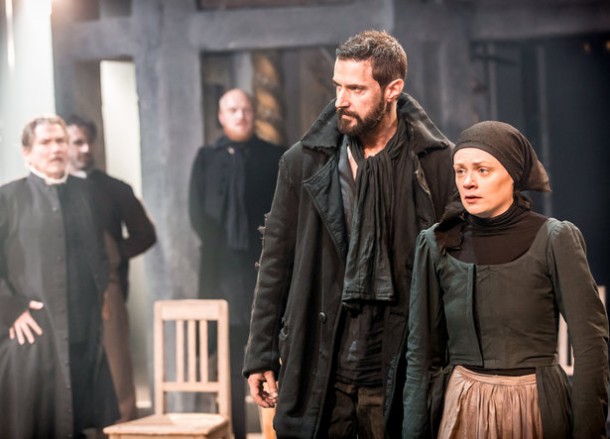Yaël Farber, director of the international hit, Mies Julie, and writer and director of the Amnesty International Freedom of Expression Award winning Nirbhaya, brought her vision to London’s Old Vic theatre for a highly anticipated production of Arthur Miller’s The Crucible. Starring Richard Armitage and Anna Madeley as the ill-fated John and Elizabeth Proctor, the production was part of The Old Vic’s second season in the round.
Farber sets a bleak and somewhat ponderous tone from the outset. Before the first dialogue is spoken, Tituba (Sarah Niles), the slave from Barbados, whose influence on several young girls is viewed as Satanic by the Salem, Massachusetts townspeople, is discovered smudging the perimeter of the stage, adding a smoky density to the already hazy atmosphere. (The fog machines seemed to run throughout the show.) Following her incantations, cast members placed the set pieces with slow, deliberate, somewhat ritualized movements.
Farber, with the assistance of Imogen Knight who is credited with the movement, makes this deliberate languid stylization a hallmark of the production, drawing out the transitions between scenes. The studied effort emphasised again and again how very important and portentous these dramatic proceedings were, an attempt, possibly, to overlay a patina of forced reverence over this play, in which questions of the sacred and the profane, sin and redemption, faith and loyalty loom so large. These theatrical touchstones are of course also symbolic, as the audience is presumed to remember the historical backdrop against which Miller wrote The Crucible—McCarthyism and the HUAC hearings. The ultimate effect, however, of the measured pace was less thought provoking than perhaps intended, creating not so much a sense of fear and reverence than a torpid atmosphere of over-played earnestness and the inescapable feeling that a long play was being made longer.
Armitage, perhaps best known for Peter Jackson’s The Hobbit trilogy of films and the BBC television series Spooks, physically embodies the role of Proctor well, with a strong stage presence and an instinctually defensive posture. He is convincingly quick to dismiss the narrow opinions and suspicions of the literal witch-hunters and ably conveys Proctor’s exasperation at the town’s first ventures into paranoia and persecution. As his predicament grows increasingly hopeless and the grim absurdity deepens, the situation gradually pulls him into a bitter and gloomy slump. However, he mostly signals his growing indignation at the appalling injustices ballooning around him by shouting. In this he is in good company with the majority of the cast, whose characters all seem to think the best way to respond to the Devil—or to those who are foolishly deluded into believing the Devil is at work—is by yelling. A lot. At each other and, seemingly, the audience. Perhaps Puritans believed that Satan could be frightened off by the sheer loudness of God’s people, although if this were so, why did they bother with all the hangings? Such are the questions this production brought to mind throughout the long evening of fog and bellowing. (Armitage’s roars sounded as if he may have been a bit hoarse—no wonder, given that it was his second performance of the day and therefore his fourth through sixth hours of bellowing.)

Arthur Miller’s The Crucible, directed by Yaël Farber with Richard Armitage as John Proctor. Photo: Johan Persson
Consequently, the most effective and moving performances of the evening were those who screamed less than the others. Although it would be a dramaturgical overstatement to label the irascible Giles Corey character as comic relief, he does provide many of the few moments of levity in the script—and the scarcity of humor amidst the grim happenings is starkly apparent in this overly sombre production. In his portrayal of Giles, William Gaunt, however, stands out not so much for the occasional laughs he brings, but for the richly layered performance he offers. His gruffness is funny, and the guilt he shows at bringing unwanted attention to his wife’s reading preferences is palpable and moving to watch. We learn of the character’s death in a bittersweet moment when it is revealed that as Giles died of being pressed to death (a gruesome practice of slowly crushing someone with heavy stones placed on them), his last words were, “More weight.” The recognition that the character is dead created a moment both poignant and ironically comic—precisely, one must think, as Miller intended and so skilfully wrote—and no doubt fueled by the excellence of Gaunt’s portrayal. It is a cliché that there is a fine line between comedy and tragedy, but it rings true in such a performance. And he doesn’t bellow constantly, making it both easier and more enjoyable to listen to him.
The other principal performance that consistently transcended the din and the fog was Adrian Schiller as Reverend Hale. Schiller displays a wonderfully crafted evolution from pious true believer in the Dark Lord’s machinations to a man broken with guilt over the carnage he believes he has helped propel. He is simply terrific, and his journey is heart-breaking to witness. It is a nuanced and surprising turn, deeply textured and always utterly believable. The life of the production seemed to surge on his every entrance. And even when he yelled (in the shout-a-thon in which he was immersed, any actor would have to from time to time), it always landed like a genuine character moment, rather than an actorly response to a directorial exhortation of “Louder!”
The two most prominent women’s roles, Elizabeth and Abigail Williams, whose lies and histrionics are at the center of the feverish prosecutions and executions, are both capably played by Madeley and Samantha Colley. Both manage to find vocal levels below the tops of their lungs and Madeley is particularly strong in her final tender scenes with Armitage, begging her husband to confess to the bogus charges—to lie—to save his own life. Colley is solid as the scheming teen, whose affair with John Proctor and desire to avoid punishment, make her into the ringleader of the girls whose accusations tear the town apart. She is especially good in the trial scene where she leads the other girls in a group (feigned) seizure as the Devil’s (accused) servant, Mary Warren (a convincing Natalie Gavin), unleashes the forces of evil upon them. Their cries and shrieks and twitches are appropriately theatrical and even a bit scary. Perhaps more than in any other moment of the play, one understands in this scene how fanaticism can instil and manipulate the paranoia of the masses. It is the production’s singularly most effective scene.
Yet, even here, one is left to ponder how much more startling it may have been had the audience’s ears not already been assaulted by the non-stop clamor generated by the cast. It is a pity, as Farber’s staging was engaging, if too blanketed in fog. There is extraordinary attention to detail (save perhaps for the rifle Proctor brandishes at one point, which looked more Old West than Puritan New England). She used the arena stage excellently, with the action unfolding from every corner and even from beneath the stage in a wonderful design touch. (Soutra Gilmour was the designer.) There was, however, a nagging feeling throughout that Farber did not fully trust either the material or her actors, superbly skilled though they obviously were. Only in a few moments and in a few performances (Schiller, Gaunt, Colley, Madeley to some extent, and Ann Firbank’s Rebecca Nurse) were nuances really allowed to come to the fore. The result is a production of extreme technical proficiency and very precise performances, but one which did not ultimately mine the rich emotional and symbolic vein for which this play is known. Despite publicity claims of being a “visceral re-imagining,” it all seemed rather by the numbers, never particularly visceral and never quite the chill-bracing theatrical wind it could be—and often felt like it wanted to be. It was engrossing to a point, it was lovely, even stunning at times, to look at through the fog, it was all very logical and orderly and dramaturgically tight, and the performances were solid and disciplined. It was even a little unnerving, but it was never terrifying, and one wants to believe this play still has the innate power to terrify. It was interesting enough, but never genuinely gripping. It was intriguing, but never really provocative. It was virtually devoid of subtlety.
Perhaps because it was mostly just very loud.
is the Founder and Artistic Director of Actors Repertory Theatre Luxembourg, a professional English-language theatre company, and an independent scholar and educator. He has published in Contemporary Theatre Review and Western European Stages and writes for the English-language version of the Luxembourger Wort, the national newspaper of Luxembourg. He has a PhD in Theatre from the City University of New York Graduate Center.
European Stages, vol. 3, no. 1 (Fall 2014)
Editorial Board:
Marvin Carlson, Senior Editor, Founder
Krystyna Illakowicz, Co-Editor
Editorial Staff:
Elizabeth Hickman, Managing Editor
Bhargav Rani, Editorial Assistant
Advisory Board:
Joshua Abrams
Christopher Balme
Maria Delgado
Allen Kuharsky
Jennifer Parker-Starbuck
Magda Romańska
Laurence Senelick
Daniele Vianello
Phyllis Zatlin
Table of Contents:
• The 68th Avignon Festival 2014, July 4 to 27: Protests and Performances by Philippa Wehle
• The Avignon Fringe Festival 2014 by Manuel García Martinez
• The Reality Bites of New Bulgarian Theatre by Dessy Gavroliva
• Happy Days: Enniskillen International Beckett Festival 2014, July 31-August 11 by Beate Hein Bennett
• Flemish Theatrical Exceptionalism Mostly Glimmers, Sometimes Wavers by David Willinger
• Shouting at the Devil (and Everyone Else): Yaël Farber’s Production of The Crucible at The Old Vic by Erik Abbott
• Mladinsko Theatre and Oliver Frljić’s Damned Be the Traitor of His Homeland! (Sibiu International Theatre Festival, Romania, 2014) by Ilinca Todoruţ
• Barcelona Theatre (2013): Responding to Spain’s Crisis by Maria Delgado
• Report from Madrid by Duncan Wheeler
• Irish Colonial History on the Hungarian Stage by Mária Kurdi
• Fantastic Realities: Actors as Puppets and Puppets as Actors by Roy Kift
Martin E. Segal Theatre Center:
Frank Hentschker, Executive Director
Marvin Carlson, Director of Publications
Rebecca Sheahan, Managing Director
©2014 by Martin E. Segal Theatre Center
The Graduate Center CUNY Graduate Center
365 Fifth Avenue
New York NY 10016





